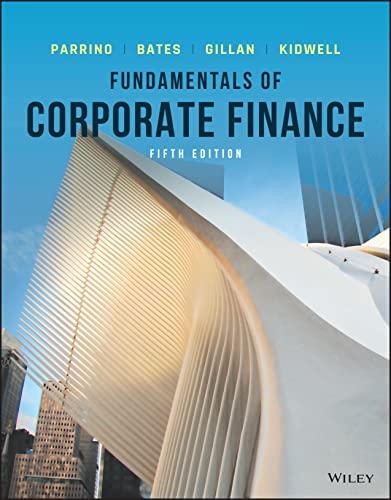Question
Use the following data to calculate your stock value. Note the following: ROE = NI / Total equity Payout ratio = total cash dividends /
Use the following data to calculate your stock value.
Note the following:
ROE = NI / Total equity
Payout ratio = total cash dividends / NI
There are 10million shares outstanding.
T-bill rate is 3.0%, S&P500 mkt return was 10.00%, and beta of this company is 1.5.
equity beta of this company is 1.5.
FCF (Free cash flow) = EBIT * (1-tax rate) + Depreciation NCS change in NWC
assume that the market value of debt is equal to the book value of debt.
| Balance sheet (in millions) of 2021 and 2022 | ||||||||
| 2021 | 2022 | 2021 | 2022 | |||||
| Current Assets | 380 | 450 | Current liabilities | 150 | 200 | |||
| Fixed Asset | 600 | 500 | Fixed Debt | 380 | 250 | |||
| Total equity | 450 | 500 | ||||||
| Total Asset | 980 | 950 | Total liabilities+equity | 980 | 950 | |||
| Income Statement (in millions) of 2022 | |
| Revenue | 500 |
| all expenses | -200 |
| EBIT | 300 |
| Interest expense | -100 |
| EBT | 200 |
| Tax | -90 |
| NI = | 110 |
Assume this company does not pay any dividend. And further assume that the Free cash flow and the earnings will grow at the constant rate of 4.5%.
Question #1. With this assumption, What should be the stock value per share using the Free Cash Flow (FCF) model?
----------------------------------------------------------------------------------
For the following questions, find the expected stock price using the table below per price ratio analyses:

QUESTION #2. Find the expected stock price for year 2017 using the p/e ratio
QUESTION #3. Find the expected stock price for year 2017 using the p/cf ratio
QUESTION #4. Find the expected stock price for year 2017 using the p/s ratio
- Formulas for the first question:
FCF = EBIT(1 Tax Rate) + Depreciation (Net) Capital Spending Change in Net Working Capital
- Formulas for the 2,3 and 3 question:
historical P/E ratio x projected EPS
historical P/CF ratio x projected CFPS
historical P/S ratio x projected SPS
\begin{tabular}{l|rrrrrr} year & 2011 & 2012 & 2013 & 2014 & 2015 & 2016 \\ \hline price & $94.50 & $100.40 & $99.10 & $97.90 & $121.50 & $136.80 \\ eps & 4.34 & 5.05 & 5.22 & 6.06 & 7.00 & 8.00 \\ cfps & 7.27 & 8.24 & 8.71 & 10.12 & 11.8 & 13.1 \\ sps & 52.6 & 58.52 & 57.9 & 60.69 & 71.6 & 78.7 \\ \hline dividend & $1.00 & $1.08 & $1.17 & $1.25 & $1.35 & $1.40 \end{tabular} \begin{tabular}{l|rrrrrr} year & 2011 & 2012 & 2013 & 2014 & 2015 & 2016 \\ \hline price & $94.50 & $100.40 & $99.10 & $97.90 & $121.50 & $136.80 \\ eps & 4.34 & 5.05 & 5.22 & 6.06 & 7.00 & 8.00 \\ cfps & 7.27 & 8.24 & 8.71 & 10.12 & 11.8 & 13.1 \\ sps & 52.6 & 58.52 & 57.9 & 60.69 & 71.6 & 78.7 \\ \hline dividend & $1.00 & $1.08 & $1.17 & $1.25 & $1.35 & $1.40 \end{tabular}Step by Step Solution
There are 3 Steps involved in it
Step: 1

Get Instant Access to Expert-Tailored Solutions
See step-by-step solutions with expert insights and AI powered tools for academic success
Step: 2

Step: 3

Ace Your Homework with AI
Get the answers you need in no time with our AI-driven, step-by-step assistance
Get Started


